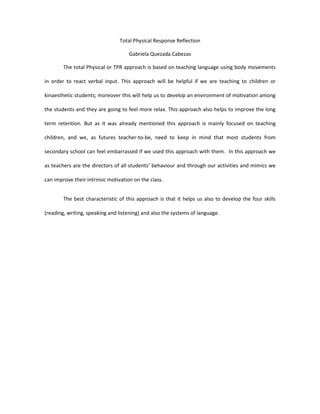Total physical response reflection
•Download as DOCX, PDF•
0 likes•58 views
Report
Share
Report
Share

More Related Content
What's hot
What's hot (17)
4 Therapies Schools Should Conduct for Autistic Children

4 Therapies Schools Should Conduct for Autistic Children
Active Learning Mixology - NCaeyc Pre-session Slides 

Active Learning Mixology - NCaeyc Pre-session Slides
Similar to Total physical response reflection
Affective effective language english language teaching method

Affective effective language english language teaching methodEduardo Hernández Rangel, MCC, PMP, ITIL Cer, Scrum Master
Similar to Total physical response reflection (20)
DAN GRUBESTU RYANSARAH LOWELLAMY STRINGEREffective

DAN GRUBESTU RYANSARAH LOWELLAMY STRINGEREffective
Affective effective language english language teaching method

Affective effective language english language teaching method
Total physical response reflection
- 1. Total Physical Response Reflection Gabriela Quezada Cabezas The total Physical or TPR approach is based on teaching language using body movements in order to react verbal input. This approach will be helpful if we are teaching to children or kinaesthetic students; moreover this will help us to develop an environment of motivation among the students and they are going to feel more relax. This approach also helps to improve the long term retention. But as it was already mentioned this approach is mainly focused on teaching children, and we, as futures teacher-to-be, need to keep in mind that most students from secondary school can feel embarrassed if we used this approach with them. In this approach we as teachers are the directors of all students’ behaviour and through our activities and mimics we can improve their intrinsic motivation on the class. The best characteristic of this approach is that it helps us also to develop the four skills (reading, writing, speaking and listening) and also the systems of language.
